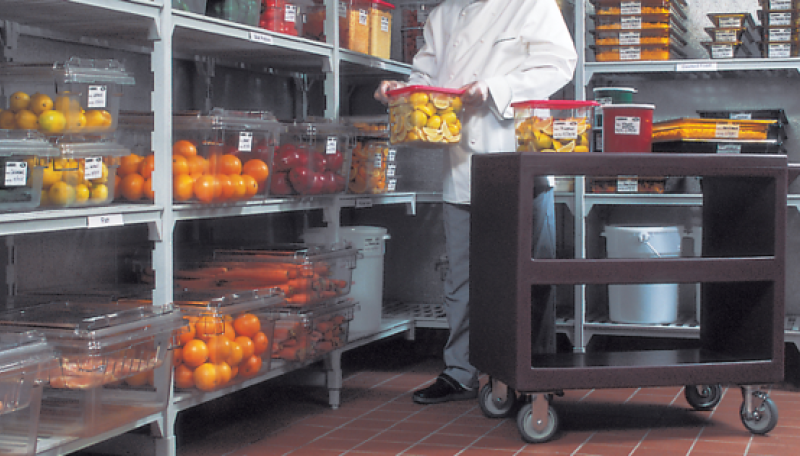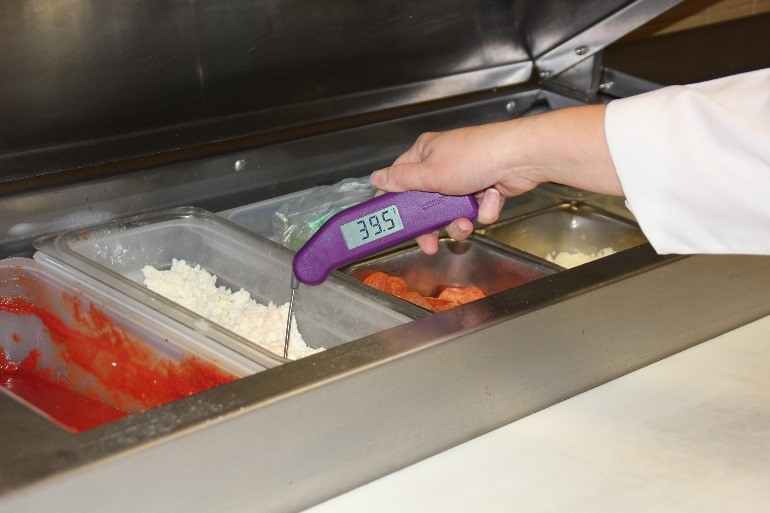Food & Lodging Safety Program

The City of Bloomington maintains a food safety program to protect public health, prevent foodborne illness and meet consumer expectations for cleanliness.
Environmental Health Specialists routinely inspect restaurants and other food facilities. Each inspector is certified by the State of Minnesota as a Registered Environmental Health Specialist / Sanitarian.
Minnesota's new Food Code went into effect January 1, 2019. Read the top 20 changes you should be aware of.
New food establishments intending to operate in Bloomington or Richfield must first apply for an Environmental Health Plan Review Permit. Please apply on the new Permit Portal. You will have to create an account and verify with an email if you have never applied for a permit with the City of Bloomington.
Please visit our Environmental Health Plan Review Handout page for more information and submittal requirements.
Once your permit application is received by staff, it will be routed to the Environmental Health Plan Reviewer to approve. After it has been approved and you have received your permit, you must call the Environmental Health Division at 952-563-8934 to schedule opening inspections.
On March 21, 2022, the City of Bloomington adopted an ordinance creating a onetime $50 application for licensed food service establishments to allow dogs in outdoor dining areas. Permits renew automatically and are printed on the food license.
Allowing customers to bring dogs into your outdoor dining area is your choice with two exceptions:
- A person with disabilities accompanied by a service animal, or
- Lawful use of a service animal by a licensed peace officer.
Requirements of this new ordinance includes:
- Providing printed signs in the permitted outdoor area,
- Not allowing dangerous or potentially dangerous dogs,
- Prohibiting employees from handling dogs,
- Not allowing dogs to contact dishes, tableware, paper products or any food service items,
- Ensuring customers keep dogs on leash & under control,
- Not allowing dogs on chairs, tables, or other furnishings, and
- Making sure dog waste is cleaned up immediately and the area is sanitized.
Submit the license application and fee payment to Business Licensing at businesslicensing@bloomingtonmn.gov, or call 952-563-8728.
If you become ill after eating at an establishment in Bloomington or Richfield, please contact us. Your report may help us discover an outbreak of foodborne illness and prevent the spread of illness to others.
Foodborne illnesses can be reported in two ways:
- Contact the Environmental Health Division
- Call (952) 563-8934
- Email envhealth@BloomingtonMN.gov
- Our business hours are 8 a.m. – 4:30 p.m. Monday through Friday.
- Contact the Minnesota Department of Health (MDH)
- Call 1-877-FOOD-ILL (1-877-366-3455)
- Submit your report using the Foodborne and Waterborne Illness Report, MDH's confidential online survey
- Email health.foodill@state.mn.us
- Their business hours at 8 a.m. - 4:30 p.m. Monday through Friday.
If someone is not available to take your call you may leave a voice message with your name and telephone number. Someone will return your call the next business day.
Environmental Health staff will interview you using a standard questionnaire that focuses on illness history and food consumption. Because foodborne illness may occur hours to days after eating contaminated food, you will be asked to recall what you consumed up to 4 days before onset of illness. Interview responses are confidential; however, questionnaires are sent to the Minnesota Department of Health in an effort to detect outbreaks beyond the borders of Bloomington or Richfield. Environmental Health staff also contact or inspect the suspected food establishments and focus on safe food handling practices and policies as part of the foodborne illness complaint response.
- Additional information about foodborne illness from the Minnesota Department of Health.
With limited exceptions, if you will be serving food at an event that is open to the public you need a temporary food license. Examples include selling concessions at a sporting event or craft fair, handing out snacks at a fundraising event, or having a restaurant cater an event not held at the restaurant that is open to the public. Please contact the Environmental Health Division if you have questions.
The Temporary Food License Requirements Information Sheet (pg. 3 & 4 on the Temporary Food Events Application pdf above) provides an overview of requirements for serving food at special events.
The Temporary Food License Application must be filled out and submitted with the required license fee 10 business days before the event.
The application can be mailed, emailed or faxed to the Licensing Division or dropped off in person at the Licensing Counter, first floor of Civic Plaza Monday-Friday, 8 AM to 4:30 PM.
The Minnesota Department of Health collects a statewide hospitality fee for all food, beverage and lodging facilities each year. The fee funds statewide food, beverage and lodging program development activities. Temporary food event license holders are also required to pay that fee. Bills are usually sent in the summer for licenses held in the previous calendar year. Click here for more information.
Factors that most often contribute to foodborne illness outbreaks, according to the the Center for Disease Control and Prevention:
- Food from unsafe sources
- Poor personal hygiene
- Inadequate cooking
- Improper holding temperatures
- Contaminated equipment
If not controlled, risk factors are more likely than other aspects of food safety to contribute to food contamination and foodborne illness. Food safety is largely based on daily control of foodborne illness risk factors. Therefore, routine inspections are directed by the establishment menu and focus on control of risk factors and additional interventions to foodborne illness. These additional interventions include insuring that the licensee:
- Employs at least one full-time state certified food protection manager – someone who has passed a food safety exam written by an approved testing company.
- Designates knowledgeable employees who monitor for safe food handling practices and properly functioning equipment, and make corrections as necessary
- Follows a policy of keeping ill employees from handling food and requires employees to report illness symptoms
- Trains employees on safe food handling practices
On average, inspectors conduct two unannounced routine inspections per year in restaurants and other high risk establishments with follow-up inspections on items not in compliance. Through uniform inspections, training and other activities, inspectors work with food employees and managers at every food establishment to ensure food safety with the common goal of preventing foodborne illness. Since January 2005, routine inspections have been based on program standards recommended by the Food and Drug Administration (FDA), the Minnesota Department of Agriculture and the Minnesota Department of Health.
Food establishments are grouped into three categories based on the kind of food offered and how it is prepared or handled prior to service. The types of establishments are:
- High Risk - A facility that offers raw animal foods, or where food is cooked, cooled, reheated or prepared a day or more in advance of service. These establishments have the most potential for the occurrence of foodborne illness risk factors due to complex food handling practices.
- Medium Risk - A facility where food has already been cooked (precooked), and preparation or handling prior to service is limited. These establishments have less potential for the occurrence of foodborne illness risk factors due to simplified food handling practices.
- Low Risk - A facility that offers only prepackaged foods like candy, chips, sandwiches and soda that require no preparation or handling prior to service. The potential for foodborne illness risk factors to occur is lowest due to limited food handling practices.
This is a collaborative partnership between the City's Environmental Health Staff and local food service industry representatives. The group meets annually and typically involves an educational presentation on relevant topics and openly discussing issues that impact the establishments. Certified food managers can also obtain continuing education credits for attending.
Certified Food Manager Requirements
If your establishment holds a Type I, II, or III license, one full-time State Certified Food Protection Manager is required. Consult the Minnesota Department of Health website for training and exams.
Certified Food Protection Manager application and certificate verification
Helpful Documents
New Food Code
Minnesota's new Food Code went into effect January 1, 2019.
you should be aware of.
Safe Food Temperatures
Serving safe food to the public is the responsibility of all employees. Taking temperatures of food helps to make sure equipment is working properly and bacteria are not multiplying.

Health and Hygiene
Ill employees can spread foodborne illness to customers. Managers must write down when employees call in sick or are sent home ill.
Signs must be posted at each handwashing sink to remind employees to wash their hands. Here are several examples.
You must have a plan on how to clean up vomiting and diarrhea in your facility. Here is some information from Olmsted County.
Allergens
There are 8 food allergens that account for the majority of allergic reaction.
- Treenuts
- Peanuts
- Soy
- Fish
- Shellfish
- Wheat
- Eggs
- Milk
Remember them with this sentence:
Today Serve Food-allergic People With Extra Safety Measures
Treenuts Soy Fish Peanuts Wheat Eggs Shellfish Milk
According to the FDA, Symptoms of food allergies typically appear from within a few minutes to 2 hours after a person has eaten the food to which he or she is allergic.
Allergic reactions can include:
- Hives
- Flushed skin or rash
- Tingling or itchy sensation in the mouth
- Face, tongue, or lip swelling
- Vomiting and/or diarrhea
- Abdominal cramps
- Coughing or wheezing
- Dizziness and/or lightheadedness
- Swelling of the throat and vocal cords
- Difficulty breathing
- Loss of consciousness
See the FDA’s website for more information.
Construction or Remodeling
New construction or remodeling of existing food or lodging facilities requires a permit and review of plans.
For more information consult the following pdfs:
If you are building or remodeling in the City of Richfield, please apply for an Environmental Health Plan Review Permit via the Permit Portal. You will have to create an account and verify with an email if you have never applied for a permit with the City of Bloomington.
Hotels and motels are licensed and inspected by the City. Lodging establishments are defined in MN Statutes and regulated by Bloomington City Code and MN Rules. Short term rentals/vacation home rentals with guests staying less than 30 days are not allowed per the City’s zoning code.
Click here for more lodging information from the Minnesota Department of Health.
Sex Trafficking Prevention Training
The Minnesota lodging industry is an important partner in preventing sex trafficking.
All owners, managers and on-site employees must complete the required training. New hires must complete it within 90 days of hire. All required staff must retake the training annually.
Minnesota Sex Trafficking Prevention and Response Training
Training topics include:
- The role of hotels and motels in preventing sex trafficking
- Support for Trafficked Youth at Safe Harbor Minnesota
- Answers to frequently asked questions
- Other topics
Bed Bugs
Pests including bed bugs are sometimes found in lodging establishments.
Find resources from the University of Minnesota Extension. The City of Minneapolis Health Departments has a fact sheet in English and Spanish.
